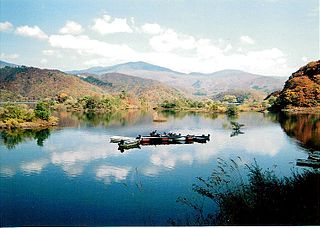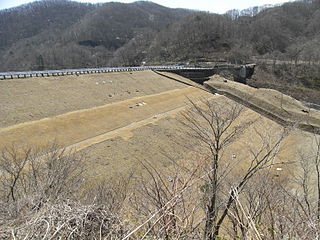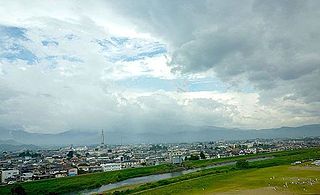| Surikamigawa Dam | |
|---|---|
Southern side of the Surikamigawa Dam | |
| Official name | 摺上川ダム(Surikamigawa Damu) |
| Location | Fukushima City, Fukushima Prefecture, Japan. |
| Coordinates | 37°55′36″N140°24′58″E / 37.92667°N 140.41611°E Coordinates: 37°55′36″N140°24′58″E / 37.92667°N 140.41611°E |
| Status | Operational |
| Opening date | 2006 |
| Dam and spillways | |
| Type of dam | Embankment dam |
| Impounds | Surikamigawa River |
| Height | 105.0 m (344.5 ft) |
| Length | 718.6 m (2,358 ft) |
| Dam volume | 8.3×106 m3 (290×106 cu ft) |
| Reservoir | |
| Creates | Lake Moniwa(茂庭っ湖Moniwakko) |
| Total capacity | 153×106 m3 (5.4×109 cu ft) |
| Active capacity | 148×106 m3 (5.2×109 cu ft) |
| Catchment area | 160.0 km2 (61.8 sq mi) |
| Surface area | 4.6 km2 (1.8 sq mi) |
| Maximum water depth | 308.5 m (1,012 ft) |
| Power Station | |
| Operator(s) | Tohoku Electric Power |
| Website Surikamigawa Dam Official Site | |
Surikamigawa Dam(摺上川ダム) is a rock-fill dam built on the Surikami River (part of the Abukuma River system) in the Moniwa area of Iizaka, Fukushima, Fukushima Prefecture, Japan. It was opened in 2006 and is administered by the Tohoku Regional Bureau Ministry of Land, Infrastructure and Transport.

The Abukuma River, with a length of 234 km (145 mi), is the second longest river in the Tōhoku region of Japan and the 6th longest river in Japan. It runs through Fukushima Prefecture and Miyagi Prefecture, rising from springs in the peaks of the Nasu mountains, collecting water from tributaries leaving the Ōu Mountains and the Abukuma Highlands, then emptying into the Pacific Ocean as a major river. It has a 5,390 km² area watershed, and about 1.2 million people live along its basin.

Iizaka was a town located in the Iizaka Area of Shinobu District, Fukushima, Japan. On January 1, 1964 it was annexed into Fukushima, Fukushima and is now a neighborhood within the city.
A multipurpose dam, it was built to provide water to the nearby cities of Nihonmatsu, Fukushima and surrounding areas. It also works in conjunction with Shichikashuku Dam and Miharu Dam to control flooding on the Abukuma River. There are also hydroelectric power facilities operated by Tohoku Electric Power.

Nihonmatsu is a city in Fukushima Prefecture, Japan. As of 1 March 2018, the city has an estimated population of 55,484 in 18,898 households, and a population density of 160 persons per km². The total area of the city was 344.42 square kilometres (132.98 sq mi). The Adachi neighborhood of Nihonmatsu was the birthplace of artist Chieko Takamura, subject of the book of poems Chieko's Sky, written by her husband Kōtarō Takamura.

Shichikashuku Dam is a rock-fill dam in the town of Shichikashuku, Miyagi, Japan, completed in 1991. The dam crosses the Shiroishi River, a branch of the Abukuma River system.

Miharu Dam (三春ダム) is a concrete gravity dam on the Ōtakine River, a branch of the Abukuma River in the town of Miharu, Fukushima in the Tōhoku region of Japan. The dam was completed in 1997.
The name of the artificial lake the dam forms was chosen from over a thousand ballots cast by the public, with Lake Moniwa(茂庭っ湖Moniwakko) ultimately being chosen.

A reservoir is a storage space for fluids. These fluids may be water, hydrocarbons or gas. A reservoir usually means an enlarged natural or artificial lake, storage pond or impoundment created using a dam or lock to store water. Reservoirs can be created by controlling a stream that drains an existing body of water. They can also be constructed in river valleys using a dam. Alternately, a reservoir can be built by excavating flat ground or constructing retaining walls and levees. Tank reservoirs store liquids or gases in storage tanks that may be elevated, at grade level, or buried. Tank reservoirs for water are also called cisterns.



















